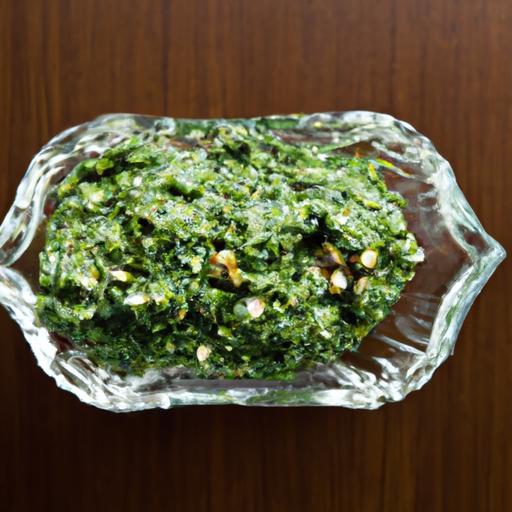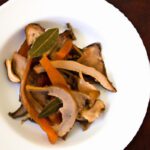In the heart of nature’s pantry lies a treasure trove of vibrant, untamed greens-wild herbs and leaves bursting with fresh, earthy flavors just waiting to be discovered. “Foraged Flavor: Crafting Wild Green Pesto with Nuts” invites you on a culinary adventure off the beaten path, where the humble pesto transforms into a celebration of foraged bounty. By blending the verdant intensity of wild greens with the rich, nutty undertones of carefully selected nuts, this recipe elevates a classic sauce into an extraordinary homage to the wild. Whether you’re a seasoned forager or a curious kitchen explorer, this guide will awaken your palate to new possibilities, proving that some of the most memorable flavors grow not in gardens, but in the wild.
Foraging Fundamentals Unlocking the Best Wild Greens for Pesto
Foraged Flavor celebrates the magic of gathering nature’s bounty and transforming it into vibrant, mouthwatering pesto. Wild greens like nettles, dandelion leaves, or wild garlic bring an earthy, bold essence that elevates every bite with a fresh, untamed character. These greens embody a unique terroir, blending deep forest aromas with grassy brightness, making your homemade pesto truly one-of-a-kind.
Prep and Cook Time
- Prep Time: 15 minutes
- Cook Time: 5 minutes (blanching wild greens)
- Total Time: 20 minutes
Yield
Approximately 1 cup of pesto, enough for 4-6 servings.
Difficulty Level
Medium – requires foraging or sourcing specialty wild greens and balancing flavors.
Ingredients
- 2 cups fresh wild greens (nettles, dandelion leaves, or wild garlic, finely washed and trimmed)
- 1/2 cup nuts (toasted walnuts or hazelnuts, see note)
- 2 cloves garlic, peeled
- 3/4 cup extra virgin olive oil
- 1/2 cup freshly grated Parmesan cheese or aged hard cheese of choice
- 1 tbsp fresh lemon juice (to brighten flavors)
- Salt and pepper to taste
Instructions
- Blanch the wild greens: Bring a pot of salted water to a boil. Drop in the wild greens and blanch for 1-2 minutes until bright green and tender. Immediately transfer to an ice water bath to preserve color and stop cooking. Drain well and gently squeeze out excess moisture.
- Toast the nuts: In a dry skillet over medium heat, toast the nuts for 3-5 minutes until fragrant and golden brown, stirring often to prevent burning. Let cool slightly.
- Blend the base: In a food processor, combine the blanched greens, toasted nuts, and garlic. Pulse a few times to coarsely chop the ingredients.
- Emulsify: Slowly drizzle in the olive oil while pulsing until the mixture becomes creamy but still has texture. Scrape down the sides as needed.
- Add cheese and seasoning: Stir in lemon juice and Parmesan cheese. Season with salt and freshly ground black pepper to taste, pulsing briefly to combine everything.
- Adjust consistency: If the pesto is too thick, blend in a little more olive oil or a splash of water. For a chunkier texture, pulse less.
- Store or serve: Transfer pesto to a clean jar or bowl. Cover tightly and refrigerate if not using immediately. It’s best enjoyed within 3 days.
Tips for Success
- Choosing Wild Greens: Opt for tender, young leaves with mild bitterness. Avoid any greens that look wilted or overly tough.
- Nut Variations: Walnuts add a rich earthiness, while lightly toasted hazelnuts contribute a sweet, buttery note. Pine nuts are classic but pricier – choose what suits your flavor preference.
- Substitutions: For a vegan version, replace Parmesan with nutritional yeast or vegan hard cheese.
- Make-Ahead: Pesto can be frozen in ice cube trays for easy portioning and longevity.
- Handling Nettles: Use gloves when harvesting and washing nettles as their tiny hairs can sting. Cooking neutralizes this effect.
Serving Suggestions
This wild green pesto shines when tossed with al dente pasta, drizzled over roasted vegetables, or spread generously on crusty artisan bread. Garnish with a sprinkle of toasted nuts, lemon zest, and extra grated cheese for an inviting presentation. Pair with fresh salad greens and crisp white wine for a perfect light meal.
| Nutrient | Per 2 Tbsp Serving |
|---|---|
| Calories | 140 |
| Protein | 4g |
| Carbohydrates | 3g |
| Fat | 13g |

Explore more delicious herbaceous recipes by checking our Herbal Pestos Collection. For detailed information on safe wild-foraging practices, visit US Forest Service Wildflower Foraging Guide.
Q&A
Q&A: Foraged Flavor – Crafting Wild Green Pesto with Nuts
Q1: What inspired the idea of making pesto from foraged wild greens?
A1: The vibrant explosion of spring growth outside our doors is nature’s pantry waiting to be explored. Foraging wild greens adds an element of adventure and sustainability to cooking-and those wild flavors can transform a humble pesto into a verdant masterpiece that sings with freshness and earthiness.
Q2: Which wild greens work best for foraged pesto?
A2: Think beyond basil! Peppery chickweed, nutty dandelion leaves, tender nettles (carefully prepared), wild garlic, sorrel, or even purslane all bring unique layers of flavor. Each patch’s personality shines through, making your pesto a gift from the local landscape.
Q3: How do you safely forage wild greens?
A3: Safety first! Only harvest from pollution-free areas-avoid roadsides and industrial zones. Identify plants positively using trusted guides or apps. Harvest sustainably: take only what you need and leave enough for wildlife and plant regeneration. And, if handling stinging nettles, use gloves to prevent irritation.
Q4: Why add nuts to wild green pesto, and which ones are best?
A4: Nuts lend richness, texture, and a subtle creaminess that perfectly balances the grassy brightness of wild greens. Classic choices like pine nuts work well, but walnuts, hazelnuts, or even pecans bring distinct earthy notes. Toast them lightly to deepen flavor and crunch.
Q5: What’s the basic process of making wild green pesto with nuts?
A5: Start by washing your greens thoroughly. Toast your chosen nuts until fragrant. Blend the greens, nuts, garlic, a generous sprinkle of salt, fresh lemon juice, and olive oil until you achieve a luscious, slightly chunky consistency. Adjust acidity and seasoning to taste.
Q6: Can this wild green pesto be used beyond pasta?
A6: Absolutely! Slather it on toasted bread for a wild green bruschetta, dollop it over grilled fish or chicken, swirl it into soups for an herbaceous lift, or stir it into grain bowls. The possibilities are limited only by your imagination-and your forage bag.
Q7: How should you store homemade wild green pesto?
A7: Store pesto in an airtight container, smoothing the surface and adding a thin layer of olive oil on top to prevent oxidation. Refrigerate for up to a week or freeze in small portions for longer shelf life-ready to infuse dishes with foraged flavor at any moment.
Q8: What’s the joy in crafting wild green pesto from foraged nuts and leaves?
A8: Beyond the delicious taste, making wild green pesto reconnects you with the rhythm of nature, sharpens your senses, and celebrates the seasonal bounty growing all around. It’s a creative ritual that turns humble ingredients into something spirited and wholly your own.
To Wrap It Up
As the vibrant hues of wild greens meet the rich crunch of foraged nuts, your homemade pesto becomes more than a sauce-it’s a celebration of nature’s bounty captured in a jar. Crafting wild green pesto invites you to step outside the usual, explore untamed flavors, and transform humble ingredients into a culinary treasure. So next time you wander through fields or forests, let your senses guide you, and bring home the fresh, earthy tastes of the wild. With every spoonful of this verdant delight, you’re not just savoring pesto-you’re savoring an experience of foraged flavor that reconnects plate to planet.


